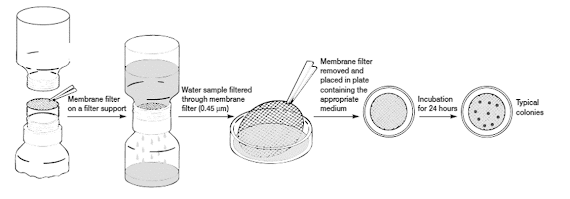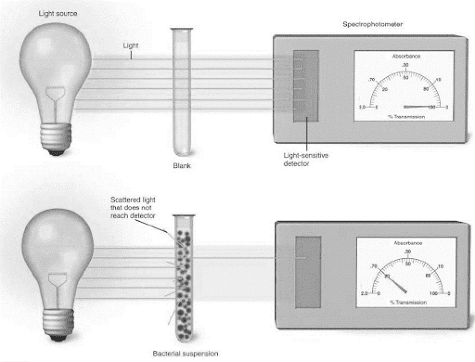Measurement of bacterial growth
Intended Learning objectives
At the end of this lecture, student will be able to:
• Differentiate between total and viable count
• Explain the different methods for total and viable
counting
Measurement of Microbial Growth
Total count
Measurement of cell numbers by direct counting using a counting chamber
– Easy, inexpensive, and relatively quick
– Gives information about the size and morphology of
microorganisms
– Petroff-Hausser counting chamber – counting procaryotes
– Hemocytometers can be used for both procaryotes and
eucaryotes
– Procaryotes are more easily counted in these chambers if
they are stained, or when a phase-contrast or a fluorescence microscope
These specially designed slides have chambers of known depth with an etched grid on the chamber bottom. The number of microorganisms in a sample can be calculated by taking into account the chamber’s volume and any sample dilutions required
Disadvantages of counting chamber
• The microbial population must be fairly large for accuracy
because such a small volume is sampled
• It is also difficult to distinguish between living and
dead cells in counting chambers without special techniques.
Coulter Counter
• Larger microorganisms such as protozoa, algae, and
non-filamentous yeasts
• The microbial suspension is forced through a small hole or
orifice.
• An electrical current flows through the hole, and electrodes placed on both sides of the orifice measure its electrical resistance
• Every time a microbial cell passes through the orifice,
electrical resistance increases (or the conductivity drops) and the cell is counted.
Coulter counter
Coulter Counter – Advantages and disadvantages
• The Coulter Counter gives accurate results with larger
cells and is extensively used in hospital laboratories to count red and white blood cells.
• It is not as useful in counting bacteria because of
interference by small debris particles, the formation of filaments, and other problems.
Membrane filtration
• The sample is filtered through a black polycarbonate
membrane filter to provide a good background for observing fluorescent objects
• The bacteria then are stained with a fluorescent dye such
as acridine orange or DAPI and observed microscopically
• Acridine orange–stained microorganisms glow orange or
green and are easily counted with an epifluorescence microscope
Counting bacteria by membrane filtration
Viable count
Colony counting using streak plate or spread plate technique
• A diluted sample of bacteria or other microorganisms is
dispersed over a solid agar surface.
• Each microorganism or group of microorganisms develops
into a distinct colony.
• The original number of viable microorganisms in the sample can be calculated from the number of colonies formed and the sample dilution.
• Since it is not possible to be absolutely certain that
each colony arose from an individual cell, the results are often expressed in terms of colony forming units (CFU) rather than the number of microorganisms.
Limitations of colony counting
• Low counts will result if clumps of cells are not broken
up and the microorganisms well dispersed.
• Counts will also be low if the agar medium employed cannot support growth of all the viable microorganisms present
• The hot agar used in the pour-plate technique may injure
or kill sensitive cells
Membrane filtration technique
• Counts of colonies growing on special membrane filters
having pores small enough to trap bacteria
• Sample is drawn through a special membrane filter
• The filter is then placed on an agar medium or on a pad
soaked with liquid media
Incubated until each cell forms a separate colony colony
count gives the number of microorganisms in the filtered • sample
Membrane filtration for total or viable count
Measurement of cell mass
• Increases in the total cell mass, as well as in cell numbers, accompany population growth
• Therefore techniques for measuring changes in cell mass
can be used in following growth
Determination of microbial dry weight
• Cells growing in liquid medium are collected by
centrifugation,
• washed, dried in an oven, and weighed.
• This is an especially useful technique for measuring the
growth of fungi.
• Time consuming, however, and not very sensitive
Turbidity and Microbial Mass Measurement
• Determination of microbial mass by measurement of light
absorption.
• As the population and turbidity increase, more light is
scattered and the absorbance reading given by the spectrophotometer increases.
Turbidimetric method
Total protein or nitrogen content
• If the amount of a substance in each cell is constant, the
total quantity of that cell constituent is directly related to the total microbial cell mass.
• For example, a sample of washed cells collected from a
known volume of medium can be analyzed for total protein or nitrogen.
• An increase in the microbial population will be reflected
in higher total protein levels
Summary
• Total count – counting the living and dead cells
• Viable count – counting only the living cells that are
capable of multiplication
• Total count is determined by counting chambers, coulter
counter, cell mass determination, turbidity measurement, membrane filtration
• Viable count can be determined by plate count and membrane filtration
Also, Visit:
B. Pharma Notes | B. Pharma Notes | Study material Bachelor of Pharmacy pdf





